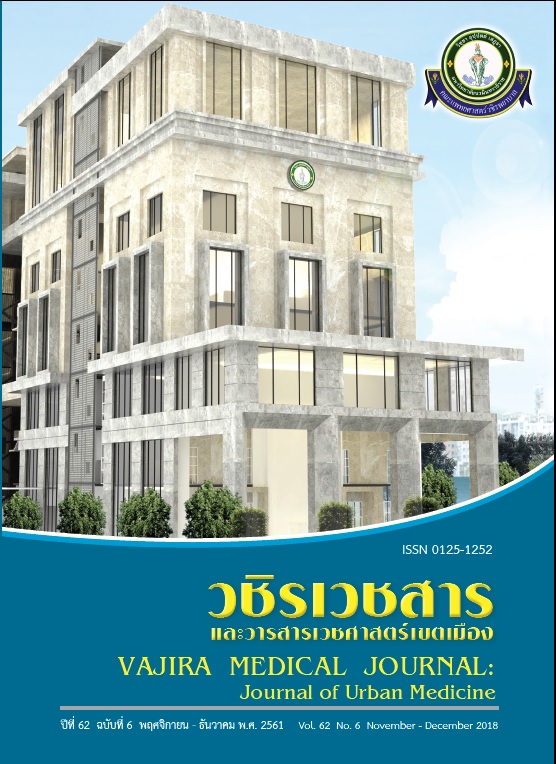Factors affecting quality of life in cochlear implant children in Ramathibodi hospital
Main Article Content
Abstract
Objective: To explore the quality of life (QOL) of the cochlear implant children and compared to QOL of normal children from previous study, and to identify the factors that affecting QOL in cochlear implant children in Ramathibodi hospital.
Methods: This study design was a cross sectional descriptive study. The participants in this study were the parents of cochlear implant children at Ramathibodi Hospital . They were interviewed by the use of the QOL questionnaire named Pediatric Quality of Life Inventory™ 4.0 Generic Core Scales (PedsQL) – parent proxy report (Thai version). The descriptive statistics, one sample t-test, simple linear regression, and multiple regression analyses were applied to data analysis.
Results: There were 88 parents in this study. Mean of QOL score according to emotional, social, school functioning, psychosocial health summary score, and total summary score were 73.29, 70.79, 68.08, 70.70 and 76.05 points, respectively. There were significantly lower when compared to score of normal children (p≤0.05). While mean of the physical health summary score was 91.86 points, which was significantly higher when compared to normal children from previous study (p≤0.05). When considering factors that affecting total summary score of QOL in cochlear implant children in this study, there were multiple handicap and family support. Regarding multiple handicap, a cochlear implant children without multiple handicap had higher QOL score when compared to children with multiple handicap. Regarding family support, a cochlear implant children with above average family support had higher QOL when compared to children with no or minimal family support.
Conclusion: The QOL scores of cochlear implant children were significant lower than QOL score of normal children. The important factors that affected QOL in cochlear implant children include multiple handicap and family support.
Downloads
Article Details
References
2 McCreery RW, Bentler RA, Roush PA. The characteristics of hearing aid fittings in infants and young children. Ear Hear.2013; 34(6):10.
3. McCreery R. Hearing Aid Assessment. In: Bradham TS, Houston KT, editors. Assessing Listening and Spoken Language in Children with Hearing Loss. California: Plural Publishing; 2014. p. 233.
4. American Speech Language Hearing Association. Effects of Hearing Loss on Development. Available at: http://www.asha.org/public/hearing/Effects-of-Hearing-Loss-on-Development/. Retrieved May 20, 2017.
5. Gifford RH. Pediatric Cochlear Implant Candidate Selection. In: Cochlear Implant Patient Assessment; Evaluation of candidacy, Performance, and Outcomes. California: Plural Publishing; 2013. p. 33-54.
6. Cole F, Flexer C. Hearing aids, cochlear implants, and FM system. In: Children with Hearing Loss Developing Listening and Talking: Birth to Six. 3rd ed. California: Plural Publishing; 2016. p. 117-66.
7. Mertes J, Chinnici J. Cochlear Implants - Considerations in Programming for the Pediatric Population. Available at: http://www.audiologyonline.com/articles/ cochlearimplants-considerations-in-programming-1011. Retrieved June 3, 2017
8. Edwards L, Hill T, Mahon M. Quality of life in children and adolescents with cochlear implants and additional needs. Int J Pediatr Otorhinolaryngol. 2012;76(6):851-7.
9. Moog JS, Geers AE, Gustus C, Brenner C. Psychosocial adjustment in adolescents who have used cochlear implants since preschool. Ear Hear. 2011;32(1 Suppl):75S.
10. Wong CL, Ching TY, Cupples L, Button L, Leigh G, Marnane V. Psychosocial development in 5-yearold children with hearing loss using hearing aids or cochlear implants. Trends Hear. 2017; doi: 10/1177/23312165177 10373.
11. Varni JW, Seid M, Rode CA. The PedsQL™: measurement model for the pediatric quality of life inventory. Med Care. 1999; 37(2): 126-39.
12. Sritipsukho P, Wisai M, Thavorncharoensap M. Reliability and validity of the Thai version of the Pediatric Quality of Life Inventory 4.0. Qual Life Res, 2013; 22(3): 551-7.
13. Looi V, Lee ZZ, Loo JH. Quality of life outcomes for children with hearing impairment in Singapore. Int J Pediatr Otorhinolaryngol. 2016; 80: 88-100.
14. Punch R, Hyde M. Social participation of children and adolescents with cochlear implants: A qualitative analysis of parent, teacher, and child interviews. J Deaf Stud Deaf Educ. 2011;16(4):474-93.
15. Huber M. Health-related quality of life of Austrian children and adolescents with cochlear implants. Int J Pediatr Otorhinolaryngol. 2005; 69 (8):1089-101.
16. Most T, Shina-August E, Meilijson S. Pragmatic abilities of children with hearing loss using cochlear implants or hearing aids compared to hearing children. J Deaf Stud Deaf Educ. 2010;15(4):422-37.
17. Leigh IW, Maxwell-McCaw D, Bat-Chava Y, Christiansen JB. Correlates of psychosocial adjustment in deaf adolescents with and without cochlear implants: A preliminary investigation. J Deaf Stud Deaf Educ. 2008;14(2):244-59.
18. De Giacomo A, Craig F, D’Elia A, Giagnotti F, Matera E, Quaranta N. Children with cochlear implants: cognitive skills, adaptive behaviors, social and emotional skills. Int J Pediatr Otorhinolaryngol, 2013; 77(12),1975-79.
19. Razafimahefa-Raoelina T, Farinetti A, Nicollas R, Triglia JM, Roman S, Anderson L. Self- and parental assessment of quality of life in child cochlear implant bearers. Eur Ann Otorhinolaryngol Head Neck Dis. 2016;133(1):31-5
20. Warner-Czyz AD, Loy B, Roland PS, Tong L, Tobey EA. Parent versus child assessment of quality of life in children using cochlear implants. Int J Pediatr Otorhinolaryngol. 2009;73(10):1423-9.
21. Oghalai JS, Caudle SE, Bentley B, Abaya H, Lin J, Baker D. Cognitive outcomes and familial stress after cochlear implantation in deaf children with and without developmental delays. Otol Neurotol. 2012; 33(6):947-56.
22. Kushalnagar P, Krull K, Hannay J, Mehta P, Caudle S, Oghalai J. Intelligence, parental depression, and behavior adaptability in deaf children being considered for cochlear implantation. J Deaf Stud Deaf Educ. 2007;12(3): 335-49.
23. Holt RF, Beer J, Kronenberger WG, Pisoni DB. Developmental effects of family environment on outcomes in pediatric cochlear implant recipients. Otol Neurotol. 2013;34(3):388.
24. Chen X, Liu S, Liu B, Mo L, Kong Y, Liu H, et al. The effects of age at cochlear implantation and hearing aid trial on auditory performance of Chinese in fants. Acta Otolaryngol. 2010;130(2):263-70.


